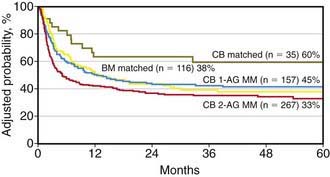Chapter 130 HSCT from Alternative Sources and Donors
Unrelated Donor Transplants
Initially, HLA polymorphism and the limitations of conventional (i.e., serological) HLA-typing techniques unfavorably affected the accuracy of matching, thus increasing rejection rates and the incidence of acute and chronic graft versus host disease (GVHD). Consequently, because the event-free survival of recipients of an unrelated donor allograft was worse than that observed when the donor was a compatible sibling transplant, there was no consensus on the use of unrelated donor transplants for nonmalignant diseases, such as thalassemia. DNA-based (i.e., high-resolution molecular) techniques for HLA typing have revealed an impressive number of new alleles within antigens that were previously defined by serology. Matching by high-resolution DNA typing reduces the risk of immune complications, namely graft rejection and GVHD, but also decreases the chance of finding a suitable donor. Nevertheless, the advent of both high-resolution molecular HLA class I and II loci-typing coupled with progress in the prophylaxis and treatment of GVHD has resulted in a reduction of transplantation-related mortality and improved outcomes. Indeed, outcomes from a fully matched unrelated volunteer donor are now similar to those of HSCT from an HLA-identical sibling, as indicated by results of unrelated donor transplantation in children with acute lymphoblastic leukemia (ALL) in the 2nd complete remission, juvenile myelomonocytic leukemia, or thalassemia (Fig. 130-1).
Umbilical Cord Blood Transplants
UCB transplantation (UCBT) is a viable option for children who need allogeneic HSCT (Fig. 130-2). Several hundred children have been cured through transplantation with either related or unrelated UCB units. UCBT offers the advantages of absence of risks to donors, reduced risk of transmitting infections, and, for transplants from unrelated donors, immediate availability of cryopreserved cells, with the median time from start of search to transplantation being only 3-4 wk. In comparison to bone marrow transplantation (BMT), advantages of UCBT include lower incidence and severity of GVHD, easier procurement and prompter availability of cord blood cells, and potential to use donors that have HLA disparities with the recipient. Despite these advantages, UCBT patients may be exposed to an increased risk of early fatal complications, mainly due to a lower engraftment rate of donor hematopoiesis, delayed kinetics of neutrophil recovery, and lack of adoptive transfer of pathogen-specific memory T-cells. Transfer of donor-derived, memory T cells significantly contributes to early immunologic reconstitution of children after unmanipulated allogeneic bone marrow or peripheral blood stem cell transplantation.
Direct intrabone transplantation








